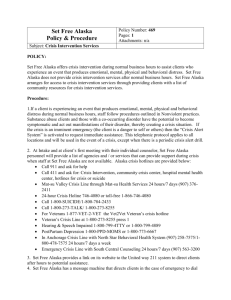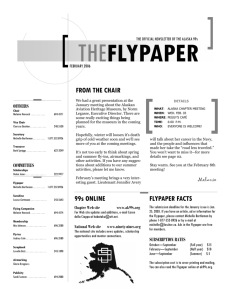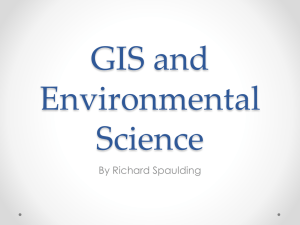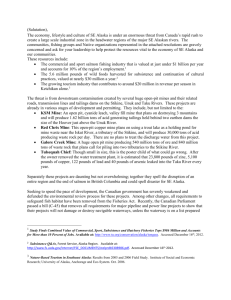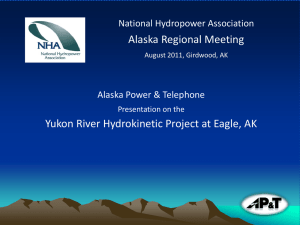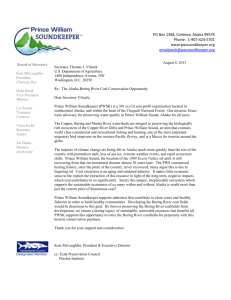Final Writeup
advertisement
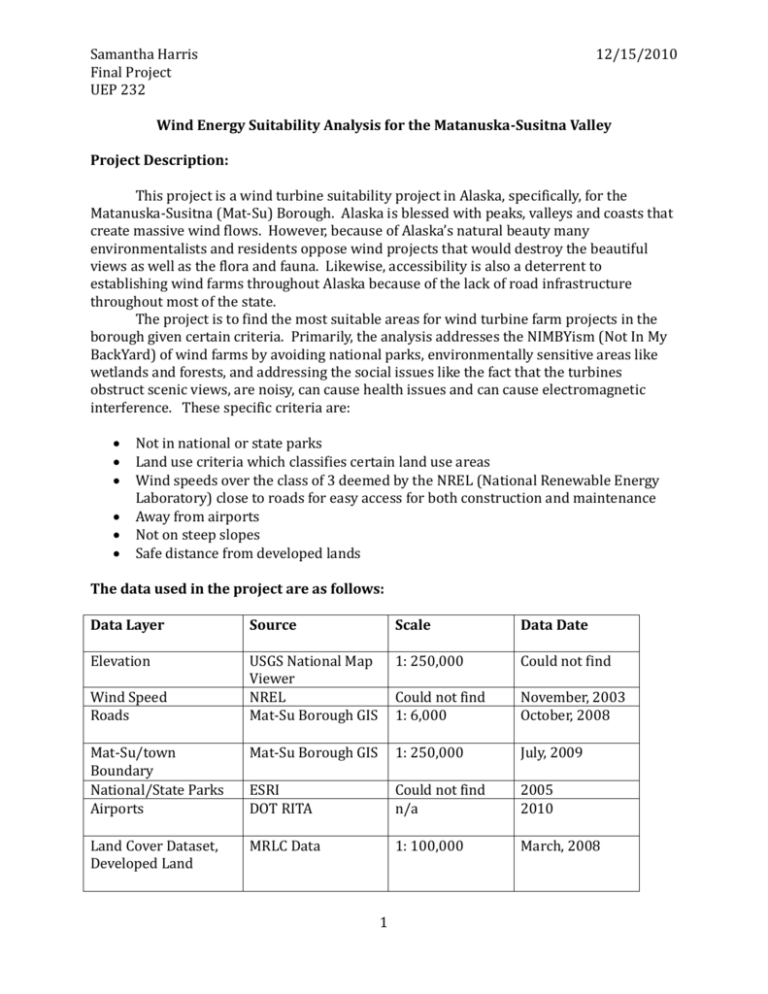
Samantha Harris Final Project UEP 232 12/15/2010 Wind Energy Suitability Analysis for the Matanuska-Susitna Valley Project Description: This project is a wind turbine suitability project in Alaska, specifically, for the Matanuska-Susitna (Mat-Su) Borough. Alaska is blessed with peaks, valleys and coasts that create massive wind flows. However, because of Alaska’s natural beauty many environmentalists and residents oppose wind projects that would destroy the beautiful views as well as the flora and fauna. Likewise, accessibility is also a deterrent to establishing wind farms throughout Alaska because of the lack of road infrastructure throughout most of the state. The project is to find the most suitable areas for wind turbine farm projects in the borough given certain criteria. Primarily, the analysis addresses the NIMBYism (Not In My BackYard) of wind farms by avoiding national parks, environmentally sensitive areas like wetlands and forests, and addressing the social issues like the fact that the turbines obstruct scenic views, are noisy, can cause health issues and can cause electromagnetic interference. These specific criteria are: Not in national or state parks Land use criteria which classifies certain land use areas Wind speeds over the class of 3 deemed by the NREL (National Renewable Energy Laboratory) close to roads for easy access for both construction and maintenance Away from airports Not on steep slopes Safe distance from developed lands The data used in the project are as follows: Data Layer Source Scale Data Date Elevation USGS National Map Viewer NREL Mat-Su Borough GIS 1: 250,000 Could not find Could not find 1: 6,000 November, 2003 October, 2008 Mat-Su/town Boundary National/State Parks Airports Mat-Su Borough GIS 1: 250,000 July, 2009 ESRI DOT RITA Could not find n/a 2005 2010 Land Cover Dataset, Developed Land MRLC Data 1: 100,000 March, 2008 Wind Speed Roads 1 Samantha Harris Final Project UEP 232 12/15/2010 Obviously, the ideal situation would be to have perfect accuracy, however, this is not an option. Because this project is a regional project, there can be room for some error. The reasonable accuracy level would be between +/- 200 meters or so. If a team were to investigate the results of the GIS analysis, something more than this estimate such as a mile, would have them wandering around looking for the site in too big of an area. Websites for the data: Mat-Su Borough GIS: http://www.matsugov.us/it/index.php?option=com_content&view=article&id=14:shapefil es&catid=5:downloadable-data&Itemid=7 Metadata website: http://ww1.matsugov.us/index.php?option=com_docman&task=doc_download&gid =101&Itemid=202 NREL: http://www.nrel.gov/gis/data_analysis.html USGS: http://nationalmap.gov/viewers.html Airports: http://www.bts.gov/publications/national_transportation_atlas_database/2010/ MRLC: http://www.mrlc.gov/ DOT: Research and Innovative Technology Administration (RITA): http://www.mrlc.gov/nlcd_multizone_map.php ESRI (M: Drive) Methodology: Chosen coordinate system: NAD 1983 StatePlane Alaska 4 coordinate system. For exactness and because so much of the valley is undeveloped, the project uses the entire Mat-Su borough for the analysis area. Using the borough boundary, the data layers were clipped using both vector and raster data clipping tools to only include the data inside the Mat-Su Borough boundary line. This not only made the layers smaller and more manageable, but more aesthetically pleasing for final map outputs. The Spatial Analysis Options were also set with the extent and analysis mask as the Mat-Su Borough boundary, and cell size of 30 meters. However, since the NAD 1983 State Plane Alaska 4 coordinate system is in feet this had to be converted to 98.45 feet, which is the same distance as 30 meters. The first step was to select relevant wind speeds by using the select by attribute tool. NREL states that out of the wind classes of 1-7, the classes over 3 are sufficient for wind farms of larger sizes. The wind classes selected were 3-7. This selection of wind classes was used to for another selection to make sure they were not located in a national or state park. Since the select by location tool does not have a “not in” tool, the selection was made for the wind classes in parks, and then the switch selection feature was used to finally obtain good wind 2 Samantha Harris Final Project UEP 232 12/15/2010 speeds not located in a park. This data layer was then converted into a raster data set containing possible wind classes. The land cover data set was downloaded from MRLC, and by using the raster clipping tool, clipped to the Mat-Su Borough boundary layer. The developed land layer was obtained from this layer by reclassifying the land uses with developed land as a 1, and everything else as a 0. It was then possible to create a dataset of only the developed land. The elevation data was obtained from USGS National Map Viewer in 4 files and by using the mosaic tool, molded together to create one raster file with the relevant elevation data within the Mat-Su Borough. A hillshade layer was created from this dem data by using the spatial analyst, surface analysis, hillshade tool. There was one issue because the coordinate system of the NAD 1983 State Plane Alaska 4 expresses the units in feet and the elevation data is expressed in meters. The Z factor, or vertical factor, had to be converted from meters into feet with the conversion factor of 3.281. To get the slope, the same spatial analyst, surface analysis was used, but this time with slope. Again because of the coordinate system, the Z factor had to be converted from meters to feet. The slope layer was then reclassified into 5 classes, but keeping the classes as natural breaks and not defining values. The airport data was downloaded from DOT RITA, and by using the select by location tool the airports only within the boundary layer were made into a new data layer. The roads were useable as is. For each input raster analysis, a spatial analysis was completed by using the spatial analyst tools provided in ArcMap. For distance to roads, and airports, straight line distance analyses were created, and reclassified to give classifying distances of 1 mile and so on. Also, values were given of 1-5, 5 being the best outcome and 1 being the worst. For the distance to roads classification, a 5 was the best if it was closest to the roads and a 1 when it was further away because this would be easier for construction and maintenance of the wind turbines. The distance to airports was the opposite given the turbines would be better not close to airports. A similar analysis was completed for distance to developed areas as distance to airports, except the initial distance was not less than 3 miles. There are many different beliefs and studies that relate to the science of the effects wind farms have on the health of nearby communities, and the minimum safe distances ranged from 1 mile to 5 miles. The largest distance of 5 miles consisted of a safe distance to offshore wind farms. None of the wind farms of this project are planned as offshore wind farms, so the minimum distance was set to 3 miles and so on. 3 Samantha Harris Final Project UEP 232 12/15/2010 The land cover data was reclassified to 6 classes to which types of land were restricted, 1, 2, 3, 4, and 5. It is important to note that there are 6 classes, because some of the data not used and classified as “no data” so it would not be used. The classifications are as follows: The next step was to use the weighted overlay tool to perform a weighted analysis with all of the input criteria of distance to roads, distance to airports, wind speeds, distance to developments, land use, and slope. The first analysis was given equal weighting adding up to 100% and the same prior classifications of 1-5. The weighted analysis was performed twice, once with equal weighting, and then with the following weightings equaling 100%: Wind: 30% Land Use: 20% Distance to Roads: 15% Distance to Airports: 15% Distance to Developed Land: 5% Slope: 15% 100% The final part of the analysis was completed by applying the grouping tool to find cells or areas that are next to each other. The output is a new layer final with the different groups and an attribute table that shows the size of the groupings. I decided on areas over 100 acres would be sufficient for a good wind farm because according to the NREL it requires approximately .25 acres for 1 turbine. For an area of 100 acres, it can be assumed that it would hold numerous turbines and could theoretically be placed out of sight. In the attribute table, there is a “count” column that provides the number of “cells” that pertain to a certain value, the values of 1-5, 5 being the best and meeting most of the input criteria. To obtain the acreage, the field calculator was used. Knowing each cell is 30m by 30m, which can be converted to 98.425 feet. The formula is as follows for the conversion to acres: (count*(98.425 *98.425))/43,560. Areas over 100 acres that have a suitability of 3, 4 or 5 were then selected out by a combination of adding a 3, 2/1/0 column, areas over 100 acres and classified by a 5 receiving a 1, areas over 100 acres and classified by a 4 receiving a 2, areas over 100 acres and classified as a 3 a 3, and everything else a 0. These 2 different types of suitable areas could then be mapped. This finally showed the best and moderate and least suitable sites for wind farms. 4 Samantha Harris Final Project UEP 232 12/15/2010 Difficulties: There were many challenges in this project. The first and most annoying being that the files were extremely large and there was not enough space on the computer drives to download many of the files, clip them and do repeated analyses of the already large files. An external hard drive was finally needed to deal with this issue. Also, since the coordinate system was projected in feet, it was necessary to convert the Z factor, or vertical factor of the elevation files and to do this it was necessary to know the conversion factors. Also, just acquiring the data for the project took hours and hours of searching and filling out online forms, lots of waiting and dealing with corrupted data. There were many complications due to the fact that if the exact criteria weren’t established from the beginning of using the data, including the extent and the cell size, then the results were incorrect and the resulting layers often didn’t function well if at all. There were also complications that were never really explained to me and still remain a mystery. For example, when using the weighted overlay table, the correct information was input, as well as the “evaluation scale” which I made sure to change before I made any changes or input any data. After saving the file after processing the overlay, if I wanted to make any changes in the same table, when I opened the table, the program arbitrarily changed my rankings. Shown below: Needless to say that repeatedly re-doing the analyses resulted in a pretty solid knowledge of the suitability analysis tools and methods. 5 Samantha Harris Final Project UEP 232 12/15/2010 Conclusions: This project is a good start for a wind farm suitability analysis, however, not very realistic without addressing factors like utility lines and if the wind energy generated would really be enough to power a city or a town in Alaska. The amount of available land for the project seems to be plentiful which can be seen in the figure below, however, the majority of these areas are not even close to the roads and appear to be in high elevations, equally as inaccessible. Even the best site, which is shown in yellow, is far from the largely populated areas so any generated wind would have to be transferred large distances. So although it’s great that the project is located far from highly populated areas because of NIMBY issues, it doesn’t appear that it will be very useful. Addressing the NIMBY criteria does not seem like a feasible analysis to actually find real usable sites. This might show why wind projects aren’t sprouting up in Alaska even though the winds are fierce. Alaska is the last frontier of the United States and many are not convinced that wind farms are necessary enough to ruin its preserved beauty. My knowledge of Arc GIS is greater than I thought it ever would be, and I don’t think it would have been had I chosen something in the state of Massachusetts. Choosing something out of state might have been more work for both me and my cool professor, but I learned a great deal about GIS and the program as well as my project. Hwoever, I also learned that GIS analysis can only take a project so far and needs to be couple with other planning knowledge and analyses. 6 Samantha Harris Final Project UEP 232 12/15/2010 Annotated Bibliography: Journal of Environmental Management: “Environmental management framework for wind farm siting: Methodology and case study.” This article is regarding a wind suitability project in Greece, and addresses the technical, economic, social and environmental aspects of the project to determine whether areas are suitable for wind energy development. The project uses a multi-criteria analysis with GIS and a case study of Lesvos Island in Greece. The constraints are listed for the island which include archaeological sites, wetlands, distance from settlements, and historical sites, airports, highly productive lands, etc. Many of these are the same constraints to the Mat-Su Valley, with archaeological sites being similar to national parks and untouched land. The study then explains an elaborate scheme for GIS analysis to result in the best suited sites for the wind projects. Although their methodology seems more convoluted than mine, this article is very helpful to me in terms of knowing specifics for wind speeds, and relevant distances from certain settlements. June 2006, Medical Engineering Magazine: “Wind Out of Their Sails” This article discusses the opposition to the Cape Wind project in Cape Cod, MA. The most discussed opposition is that the turbines will destroy the beautiful view from Cape Cod because they will be placed off shore in the ocean. The other issues of how the turbines will impinge on wildlife and the environment are there as well, but primarily it is one of NIMBY. Nobody wants to live in a million dollar house with turbines obstructing the view out the window. This battle has gone on for years, and oppositionists have searched for every loophole and fiercely battled the turbines. This same battle happens in the Mat-Su Valley because of its natural beauty, more so, because Alaska is still thought of as the last frontier with so much untouched, undeveloped land. May/June 2010: Rural Cooperatives: This article is short, but important because it discusses a wind farm in a rural area, Unalakleet Valley funded by the $250million Alaska Renewable Energy Fund. This area is not a tourist site and not highly populated. Although the area is nonetheless beautiful, the wind far was not opposed and was primarily thought of as a sustainbility project because the people were forced to spend a lot of money to power their village due to the lack of state infrastructure and higher energy prices. This project is different than the Mat-Su Valley but does show that the state has funding for wind energy as well as motivation. Renewable Energy, September 2001: “Developing and applying a GIS-assisted approach to locating wind farms in the UK.” This article discusses Geographical Information System (GIS)-assisted wind farm location criteria that were developed for the UK due to the increased demand for wind energy. This article is dated, but provides an excellent history of wind energy projects. The criteria used for the case study in Lacashire, UK, were physical, economic, environmental impact, resource, 7 Samantha Harris Final Project UEP 232 12/15/2010 visual and planning considerations. Specifically, these are proximity to residential areas, noise/nuisance, shadow flicker, greenbelt, topography, ecology, agricultural land classification, conservation areas, and distance from electricity gridlines. The private consultancies listed the following factors: wind speed, prevailing wind, terrain, adjacent terrain, vegetation, proximity to residential areas, noise and appearance. They provide their methodology and results of the study. This article with the case study of Greece provides excellent information because I’ll be doing a similar suitability analysis. These following articles were found for Assignment 1 and are still relevant: The article “Wind and Sun and Farm-Based Energy Sources,” by Don Cormis in the Journal, Agricultural Research, specifically sites Alaska, Texas and Minnesota as prime states for wind energy because of the large flat, remote areas. Specifically in Alaska, there are many remote communities and areas that could easily receive most, if not all, of their energy from wind turbines. The Matanuska-Susitna Valley in Alaska is thought of as a suburban area of Alaska, and as well could easily be powered by wind energy, for at least some parts of the community. The article also states that Alaska would not be a candidate for solar panels because the state doesn’t receive enough sunlight, especially during the winter. The article “Steel Forests or Smoke Stacks: the Politics of Visualization in the Cape Wind Controversy,” by Roopali Phadke in the Environmental Politics Journal, maps out the issues of NIMBYism and the Cape Wind Project which is much like the NIMBYism and opposition to wind projects seen in the Mat-Su Valley. Although this is not specifically Alaska, I think it’s critical to look at one of the most publicized wind projects and its opposition. There are not a lot of journal articles written specifically regarding the opposition in Alaska, but there are a lot of web sources, which have the same information. However, this article analyzes how powerful NIMBYism is and its affect on policies. This is a news article http://www.alaskapower.org/pdf/windvalley.pdf proving that the wind turbines are desired in the valley. As a previous resident of the area, I too can agree with the absurd amounts of winds, especially those that typically blow out our vehicle windows. It’s clear that small area wind projects, or backyard wind projects are possible, but what I want to find out is if large-scale projects are possible and to what extent. 8
